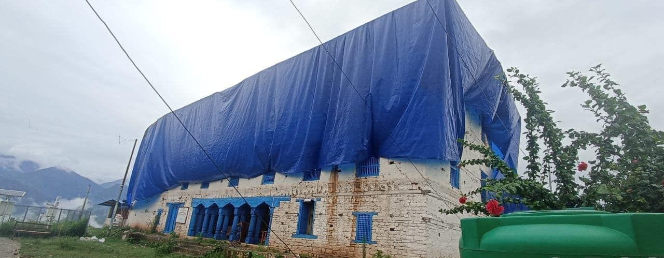The historic Jajarkot Palace, built in 1795 AD, is currently covered with tarpaulins following damage from a recent earthquake. Chief District Officer Umakanta Adhikari reported that the palace suffered significant damage during the earthquake centered in Ramidanda on November 3. To protect it from rain, tarpaulins have been used as a temporary measure. The palace had previously been damaged by two other earthquakes and was rebuilt each time, but this time reconstruction has not yet begun.
The tarpaulins were provided with assistance from the Jajarkot Division Forest Office, according to CDO Adhikari. Due to the extreme risk posed by the damage, covering the palace with tarpaulins was deemed necessary. Although the palace had been restored after two previous earthquakes, this recent quake caused severe damage, and the reconstruction has yet to be undertaken.
The palace was rebuilt after the 1934 earthquake by Bhaktapur’s Newar engineer, Nakche, highlighting its historical and archaeological importance. It is not only a key landmark in Jajarkot but also a major tourist destination in the Karnali region. Following the damage, district administration and other services have been relocated to the palace grounds.
In recent decades, the building known as Jajarkot Palace housed various government offices, which have now been moved to temporary structures due to safety concerns. The palace, also known as the “White Palace,” has withstood three major earthquakes. The current damage has resulted in cracks, posing further risks.
The palace was included in the government’s list of 100 tourist destinations a few years ago. Local civic leader Rajendra Bikram Shah mentioned the added challenge of preserving this historical site in light of the earthquake damage. “The palace, which has been rebuilt twice before, is now at risk again. It’s essential to preserve this piece of our district’s history,” Shah said. “In the past, when Jajarkot was a kingdom, the palace was rebuilt with the labor of the people, but timely reconstruction is not as easy now.”
The palace suffered destruction during the 8.0 magnitude earthquake centered in Nepal and India on January 15, 1934. It was originally constructed on the highest part of Khalanga during the reign of King Indra Narayan Shah, who chose the site for its strategic advantage. Previously, there was a “Red Palace” built in 1768 by King Hari Shah in the same area, which now houses government offices.
The Red Palace, built 27 years before the White Palace, was also damaged by the 1990 earthquake with an epicenter in Udayapur, which registered 6.9 on the Richter scale. The western section of the palace, known as “Pashchim Naal,” was particularly affected and was reconstructed in 1994.
Seven kings ruled from Jajarkot Palace after Indra Narayan, with the last king being Prakash Bikram Shah. Before Indra Narayan, kings from Hari Shah to Gajendra Narayan Shah ruled from the Red Palace. According to Rajendra Bikram Shah, government operations have been conducted from both the White and Red Palaces since 1960. In 1960, Prakash Bikram Shah sold the palace buildings to the Nepal government for NPR 60,000, after which they became government property.
In the upper Thaple area of Khalanga, two private houses also referred to as palaces were built with community labor. One house was constructed in 1885 by the sons of King Jung Bahadur Shah – Samardhwaj Shah, Randhwaj Shah, and Surbahadur Shah. The other was built in 1893 by his other sons – Shaktivardhan Shah, Amar Bahadur Shah, Narshamsher Shah, and Narjung Shah. These houses, though palace-like, were not used for governance but as residences for the king’s relatives.
Both these historical buildings, which had survived previous earthquakes, were destroyed in the recent quake. Additionally, old physical structures around the palace were also severely damaged.






